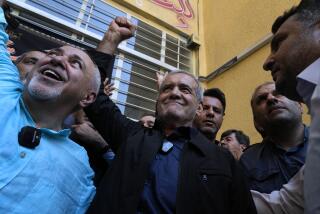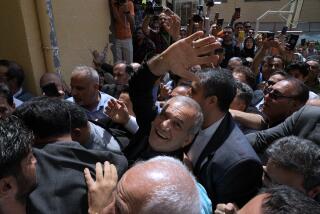A Crack in the Clerics’ Control, Gradually Widening
Iranian President Mohammad Khatami’s statement two weeks ago about opening a dialogue with the United States has as much to do with internal Iranian politics as with the Islamic Republic’s relationship with the United States. In essence, it signals the next phase of the evolving Iranian Revolution. Pitting reformers led by Khatami against the Islamic conservatives, the opening to the United States is one part of the equation that will decide whether Iran is going to live by the dictates of the people or whether government will remain the exclusive realm of the mullahs.
At the core of the debate over Iran’s future is the contested view of religion and the state. Unlike the majority Sunni branch of Islam where there is no formal clerical hierarchy, Shiism invests its spiritual leaders with absolute authority over the faithful. The faithful wield their power as individuals by choosing which theologian among many to follow. In turn, a cleric rises to the coveted designation of ayatollah by the number of followers he attracts. Thus power is cyclical. It moves from the respected cleric to the people who choose a spiritual guide back to the cleric, whose ultimate authority is determined by the number of his devoted followers. In this respect, Shia Islam is both authoritarian and compatible with the concept of democratic leadership.
Before the 1970s, religious tradition taught that the pious never corrupted themselves by engagement in secular affairs. It was Ayatollah Ruhollah Khomeini who revolutionized Shia Islam in Iran by converting religion into a political vehicle. In his theory of government, called the Velayat-e Faqih, or guardianship of the jurist, Khomeini declared that only the most learned of the clergy held the knowledge and wisdom to rule both religious and secular affairs, under the title of “supreme leader.” This man would be chosen by a constitutionally prescribed committee of clerics and serve at their pleasure. The president, also a cleric, would be the elected head of state.
While he was successful in leading a broad-based revolution to topple the shah, Khomeini failed to win an overwhelming mandate for his concept of Islamic government. Much of the opposition came from within the Shia religious hierarchy, where some saw in the Velayat-e Faqih the soiling of religion with politics. The opponents of Islamic government withdrew behind the walls of the religious schools, and the political mullahs took their place at the controls of the Islamic Republic of Iran.
The West never made the distinction between the two camps. Since 1979, the United States in particular has seen Iranian Shiism as a monolith fanatically devoted to a theocracy. The perception was not all wrong. In his role as supreme leader, Khomeini commanded both the right and the legitimacy to force his will on the Islamic state as he conceived it. But at his death in 1989, the system began to falter.
Khomeini’s successor, Ayatollah Ali Khamenei, held political credentials bestowed by the revolution but he lacked the religious credentials necessary to give him the authority his office demanded. At the same time, the failures of Islamic government to meet the expectations of the revolution ate away at the credibility of Khomeini’s Velayat-e Faqih. In escalating numbers, Iranians took up a renewed search for the proper balance between the secular and the religious and between representative government and theological dictatorship. Part of that debate involved Iran’s relationship with the rest of the world.
Taking office alongside Khamenei in 1989, President Hashemi Rafsanjani put the interests of Iran ahead of the Islamic Revolution. He pushed to reform the economy by replacing mullahs in government with technocrats educated in the skills the country needed. He tried to loosen the tight social strictures so obnoxious to a majority of the population. And he sought, not always successfully, to leave Iran’s Gulf neighbors in peace and to open channels of communication with the United States. Every step of the way, he confronted the political mullahs who dug in to protect the status quo and with it the prerogatives of clerical rule.
As Rafsanjani’s presidential term began to run out this year, Mohammad Khatami, another cleric, stepped forward with a popular agenda. While pledging to uphold the values of Islam, Khatami promised the electorate the rule of law and an end to the arbitrary power wielded by the political mullahs. The people responded and were joined by those clerics who had always opposed the Velayat-e Faqih. Last May, Iranians gave Khatami 70% of the almost 30 million votes cast.
The conservatives have refused to bend to the new order. At their urging, Ali Khamenei, the spiritual leader, recently announced that Ayatollah Hussein Ali Montazeri would be tried for treason for calling for an end to the Velayat-e Faqih. And at last week’s meeting of the Conference of Islamic Organizations in Tehran, Khamenei unleashed the hard-line rhetoric of the revolution, diminishing Iran’s carefully orchestrated moment on the world stage.
In the Iranian political system in which the president shares power with both an elected parliament and an appointed council of religious leaders, it is Khamenei who reigns supreme. As the faqih, he is the final judge over acts of government whether initiated by the president or the parliament. Therefore, if the secular and religious reformers behind Khatami are to achieve their goals, they must win Khamenei’s support or, failing that, overturn the whole concept of the faqih. Nowhere has notice been better served about the impending battle between the reformers and the Islamists than in the announcement that Iran seeks a new relationship with the United States, the conservatives’ Great Satan.
In what appears as a power struggle between the president and the conservatives over control of the Iranian state, all the elements of the Iranians’ political odyssey of the 20th century are present--the rights of the people as expressed in the Constitutional Revolution of 1905-1911, the nature of authority as demonstrated by the revolution against the shah and the place of religion in the state as defined by the Velayat-e Faqih.
It is in everyone’s interest--Iranians as well as Westerners and other outsiders--that the Islamic Republic continue to move from theocracy toward democracy and by evolution, not revolution.
More to Read
Sign up for Essential California
The most important California stories and recommendations in your inbox every morning.
You may occasionally receive promotional content from the Los Angeles Times.










